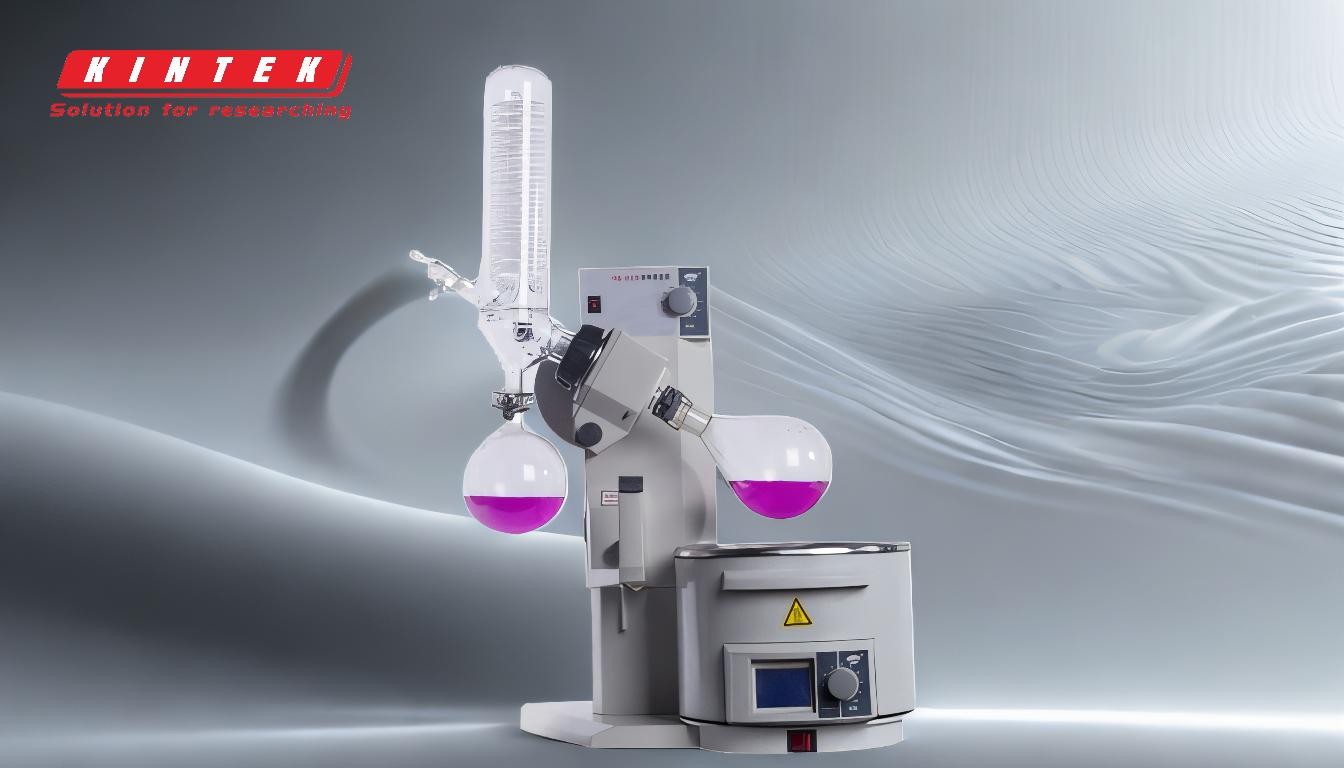A vacuum is applied in a rotary evaporator to lower the pressure within the system, which in turn reduces the boiling point of the solvent. This enables the solvent to evaporate at lower temperatures, protecting temperature-sensitive samples from degradation and ensuring a controlled distillation process. Additionally, the vacuum prevents volatile vapors from escaping into the environment, enhancing safety and efficiency. The use of a vacuum also minimizes the risk of bumping, improves solvent-product separation, and allows for precise control over the evaporation rate, making the process faster and more reliable.
Key Points Explained:

-
Lowering the Boiling Point of Solvents:
- A vacuum reduces the pressure inside the rotary evaporator, which directly lowers the boiling point of the solvent. This means the solvent can evaporate at a much lower temperature than it would under normal atmospheric pressure.
- For example, water boils at 100°C at standard pressure (1 atm), but under a vacuum, it can boil at temperatures as low as 40°C or even lower, depending on the vacuum level.
- This is particularly important for heat-sensitive compounds that could degrade or lose their integrity at higher temperatures.
-
Protecting Temperature-Sensitive Samples:
- Many compounds, such as natural extracts, pharmaceuticals, or delicate organic molecules, are sensitive to heat. By evaporating solvents at lower temperatures, the vacuum ensures that these compounds remain stable and intact during the distillation process.
- This preservation of sample integrity is critical in industries like food, cosmetics, and pharmaceuticals, where the quality and properties of the final product are paramount.
-
Preventing Volatile Vapor Release:
- A vacuum creates an airtight system that prevents volatile vapors from escaping into the surrounding environment. This is crucial for safety, as many solvents are flammable, toxic, or hazardous.
- By containing these vapors, the vacuum minimizes the risk of exposure to harmful chemicals and reduces the likelihood of accidents in the laboratory.
-
Improving Efficiency and Control:
- The vacuum allows for precise control over the evaporation rate by adjusting the pressure. This ensures a more controlled and efficient distillation process, reducing the time required to remove solvents.
- Faster evaporation rates also mean quicker turnaround times for experiments or production processes, improving overall productivity.
-
Reducing the Risk of Bumping:
- Bumping occurs when a liquid boils too rapidly, causing violent splashing or ejection of the sample. This can lead to sample loss, contamination, or damage to equipment.
- A vacuum helps mitigate bumping by creating a more stable and controlled evaporation environment, ensuring a smoother and safer process.
-
Enhancing Solvent-Product Separation:
- The vacuum improves the separation of solvents from the desired product by ensuring that the solvent evaporates completely and efficiently. This results in a purer final product with minimal residual solvent.
- This is especially important in applications like chemical synthesis or purification, where the quality of the final product depends on the complete removal of solvents.
-
Energy Efficiency:
- By lowering the boiling point of the solvent, a vacuum reduces the need for excessive heat, making the process more energy-efficient. This not only saves energy but also reduces operational costs.
-
Applications Across Industries:
- The use of a vacuum in rotary evaporation is essential in various industries, including pharmaceuticals (for drug purification), food and beverage (for flavor and aroma extraction), and chemical research (for solvent recovery and compound isolation).
- Its versatility and effectiveness make it a cornerstone technique in many laboratory and industrial processes.
In summary, applying a vacuum in a rotary evaporator is a fundamental aspect of the process, offering benefits such as lower boiling points, sample protection, safety, efficiency, and improved product quality. These advantages make it indispensable for a wide range of applications in scientific research and industrial production.
Summary Table:
| Key Benefit | Explanation |
|---|---|
| Lower Boiling Points | Reduces solvent boiling points, enabling evaporation at lower temperatures. |
| Sample Protection | Prevents degradation of heat-sensitive compounds during distillation. |
| Safety | Contains volatile vapors, reducing exposure to hazardous chemicals. |
| Efficiency & Control | Allows precise control over evaporation rates for faster and reliable processes. |
| Reduced Bumping Risk | Minimizes violent boiling, ensuring a smoother and safer process. |
| Improved Separation | Enhances solvent-product separation for purer final products. |
| Energy Efficiency | Reduces heat requirements, saving energy and operational costs. |
| Wide Applications | Essential in pharmaceuticals, food, and chemical research industries. |
Optimize your distillation process with a rotary evaporator—contact our experts today for tailored solutions!












